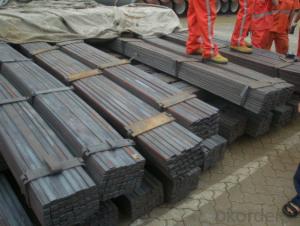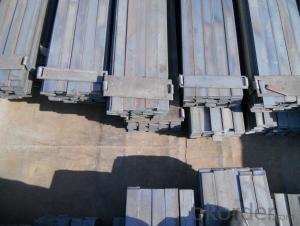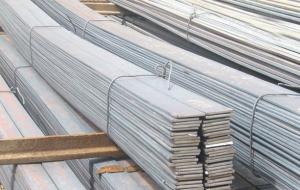Hot Rolled Flat Bar with Material Grade Q235B
- Loading Port:
- Tianjin
- Payment Terms:
- TT OR LC
- Min Order Qty:
- 25 m.t
- Supply Capability:
- 10000 m.t/month
OKorder Service Pledge
OKorder Financial Service
You Might Also Like
Product Description:
OKorder is offering high quality Flat Bar at great prices with worldwide shipping. Our supplier is a world-class manufacturer of steel, with our products utilized the world over. OKorder annually supplies products to European, North American and Asian markets. We provide quotations within 24 hours of receiving an inquiry and guarantee competitive prices.
Product Applications:
Flat Bars are ideal for structural applications and are widely used in the construction of buildings and bridges, and the manufacturing, petrochemical, and transportation industries.
Product Advantages:
OKorder's Flats Barare durable, strong, and resist corrosion.
Main Product Features:
· Premium quality
· Prompt delivery & seaworthy packing (30 days after receiving deposit)
· Corrosion resistance
· Can be recycled and reused
· Mill test certification
· Professional Service
· Competitive pricing
Product Specifications:
Manufacture: Hot Rolled
Grade: Q195 – 235
Certificates: ISO, SGS, BV, CIQ
Length: 6m – 12m, as per customer request
Packaging: Export packing, nude packing, bundled
Chemical composition of Q235
Alloy No | Grade | Element(%) | ||||
C
| Mn
| S
| P
| Si
| ||
Q235
|
B
|
0.12—0.20 |
0.3—0.7 |
≤0.045 |
≤0.045
|
≤0.3
|
Physical properties of Q235
Alloy No | Grade | Yielding strength point(Mpa) | Tensile strength (Mpa) | Elongation after fracture(%) | ||||||
Thickness (mm) | Thickness (mm) | |||||||||
≤16 | >16--40 | >40--60 | >60--100 | ≤16 | >16--40 | >40--60 | >60--100 | |||
≥ | ≥ | |||||||||
Q235 |
B |
235 |
225 |
215 |
205 |
375--500 |
26 |
25 |
24 |
23 |
FAQ:
Q1: Why buy Materials & Equipment from OKorder.com?
A1: All products offered byOKorder.com are carefully selected from China's most reliable manufacturing enterprises. Through its ISO certifications, OKorder.com adheres to the highest standards and a commitment to supply chain safety and customer satisfaction.
Q2: How do we guarantee the quality of our products?
A2: We have established an advanced quality management system which conducts strict quality tests at every step, from raw materials to the final product. At the same time, we provide extensive follow-up service assurances as required.
Q3: How soon can we receive the product after purchase?
A3: Within three days of placing an order, we will begin production. The specific shipping date is dependent upon international and government factors, but is typically 7 to 10 workdays.
Images:


- Q: Can steel flat bars be used for making conveyor systems?
- Conveyor systems can indeed be constructed using steel flat bars. Renowned for their robustness, longevity, and immunity to rust, steel flat bars are an optimal selection for handling substantial loads and enduring continuous usage. The bars' flat structure facilitates effortless fastening of rollers or other elements, streamlining the assembly and personalization of the conveyor system. Moreover, steel flat bars can be conveniently welded or bolted together, presenting versatility in fashioning and erecting conveyor systems of diverse dimensions and arrangements.
- Q: Can steel flat bars be used as reinforcement in concrete?
- Steel flat bars can indeed serve as reinforcement in concrete. They are widely recognized as either flat bars or flat steel bars. Concrete structures frequently incorporate these bars to bolster their strength, longevity, and overall stability. By integrating the steel bars into the concrete matrix, they confer tensile strength and safeguard against cracking or failure when subjected to a load. Utilizing flat bars as reinforcement in concrete yields numerous benefits, including heightened resistance to bending, augmented load-bearing capacity, and enhanced structural integrity.
- Q: What about the installation height of the socket and the height of the ground flat steel?
- If the construction unit, design institute and contact Party A drawings or design change
- Q: The function of ground lead out galvanized flat steel
- Use and test, debug, you must use lead line. In accordance with the D501 specification, its cross section is not less than 4*40.
- Q: What is the maximum length-to-width ratio for steel flat bars?
- The specific manufacturing standards and requirements will determine the maximum length-to-width ratio for steel flat bars. Typically, the length-to-width ratio for steel flat bars is approximately 6:1. In other words, the bar's length can be up to six times its width. It is essential to consider that this ratio can vary depending on the specific application or industry standards.
- Q: Can steel flat bars be hardened or heat treated?
- Yes, steel flat bars can be hardened or heat treated. Heat treatment processes such as quenching and tempering can be applied to steel flat bars to enhance their strength, durability, and other mechanical properties.
- Q: Are galvanized flat steel and angle steel the same price?
- This is not to say that depends on how you choose, simply said the product itself is good a bit different, if you choose the amount of zinc is not the same, the price will be different. If there is anything you need for this piece of steel, you can call on me. I am in Tianjin, Tangshan, a generation of steel business.
- Q: Are steel flat bars suitable for marine environments?
- Steel flat bars can be suitable for marine environments, but it depends on the specific type of steel and the level of exposure to saltwater or other corrosive elements. Stainless steel flat bars, particularly those made from marine-grade stainless steel such as 316 or 316L, are highly resistant to corrosion and are commonly used in marine applications. These stainless steel flat bars have high levels of chromium and molybdenum, which provide excellent resistance to saltwater, humidity, and other corrosive agents found in marine environments. However, not all steel flat bars are suitable for marine environments. Ordinary carbon steel flat bars are prone to corrosion when exposed to saltwater and can quickly deteriorate. If carbon steel is used in marine applications, it needs to be properly protected with coatings or galvanization to prevent corrosion. In summary, stainless steel flat bars, particularly marine-grade stainless steel, are ideal for marine environments due to their excellent corrosion resistance. On the other hand, ordinary carbon steel flat bars should be avoided unless adequately protected to prevent corrosion.
- Q: Can steel flat bars be used for making brackets or supports for automotive accessories?
- Yes, steel flat bars can be used for making brackets or supports for automotive accessories. Steel is a strong and durable material that provides excellent structural support, making it suitable for various applications in the automotive industry.
- Q: Can steel flat bars be easily machined?
- Steel flat bars are capable of being machined with ease. Due to its exceptional machinability properties, steel is extensively utilized in various industries. It can effortlessly be manipulated, cut, and fashioned into diverse forms, including flat bars. Milling, drilling, turning, and grinding are among the machining processes that can be effortlessly executed on steel flat bars. Nevertheless, the machinability of steel may differ based on factors such as its composition, hardness, and other variables. To achieve optimal outcomes, it is crucial to carefully consider the specific type of steel and its properties, ensuring the utilization of appropriate machining techniques and tools.
Send your message to us
Hot Rolled Flat Bar with Material Grade Q235B
- Loading Port:
- Tianjin
- Payment Terms:
- TT OR LC
- Min Order Qty:
- 25 m.t
- Supply Capability:
- 10000 m.t/month
OKorder Service Pledge
OKorder Financial Service
Similar products
Hot products
Hot Searches
Related keywords



























